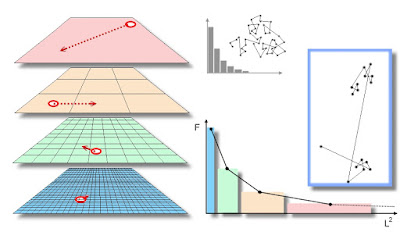Lab Mice Join the Zoomers Club

In a recent post I summarized the Zoomer model, a population level version of Multi-scaled random walk (MRW). Interestingly (in fact, thrillingly!) I just discovered a recent paper on the statistical properties of movement of the B6 strain of laboratory mice (Shoji 2016), which indirectly supports an important statistical-mechanical assumption both under the zoomer concept and the MRW. Before turning towards movement of mice, I recap a basic property of the Zoomer model, and its coherence with the complementary individual-level process. The illustration above is copied from Gautestad and Mysterud (2005), and illustrates the zoomer principle from the individual level; i.e., from the perspective of Multi-scaled random walk (MRW). To the left: individual zoomers are in the process of relocating themselves at length L at respective spatial scales (indicated by virtual grid resolutions) during a given time period T=M*t, where t is the unit time scale and series length M is large. Cons...

